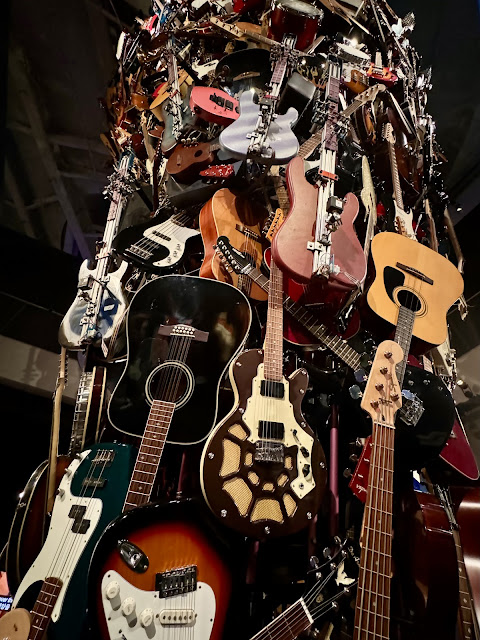If your pockets were as deep as those of Paul Allen's, the co-founder of Microsoft, you wouldn't have to go to the toy store to purchase your action figures. You simply could buy them from the movie productions, like Mars Attacks!, that spawned them.
You also could commission Frank Gehry to design a building to house your collection. Seattle's Museum of Pop Art, aka MPoP, recalls his much more elegant Guggenheim in Bilbao and Disney Hall in Los Angeles.
It may have looked more appealing in model form. Especially if you'd smoked a little weed.
Fortunately, the museum works better inside.
I'll say one thing for the collection: it's electic, at least from a baby boomer's perspective like mine. If Allen had lived--he died five years ago--we would be the same age. Who among our generation doesn't remember was watching The Wizard of Oz when it appeared annually on television?
But my taste eventually took the Camp fork in the pop culture road. His veered more toward science fiction, fantasy and horror which may explain why the museum didn't engage me as much as I hoped.
Our tastes intersected with Lost In Space, adapted from Swiss Family Robinson, my favorite Disney movie as a kid but seeing the costume that Billy Mumy wore isn't nearly as much fun as watching the five-minute promo CBS showed its affiliates before the show premiered in 1965. The show itself took place in 1997!
A few items interested me for reasons unrelated to their display. Thom and I stumbled upon the location where Planet of the Apes was filmed last summer on our trip to LA.
I've never read a Harry Potter book or seen one of the movies but I can assure you that Daniel Radcliffe totally deserved his Tony for Merrily We Roll Along.
And I just like how these bat bombs from Batman Forever photographed.
Allen conceived the place as the Experience Music Project in homage to Jimi Hendrix. Its opening in 2000 put Seattle on my list of cities to revisit.
You can watch clips of Hendrix performing in the auditorium.
Hendrix played this Fender Stratocaster at Woodstock. Some of the kinder architecture critics suggested its shape inspired Gehry's design for the Experience Music Project.
You'll find one of Prince's guitars, too.
In fact, there's a guitar tower, easily the most memorable thing about the museum.
Nirvana fans may disagree. While Kurt Cobain's signature look is on view in the main gallery, there's an entire room devoted to the band. I was always more glam than grunge
. . . although Hole's Live Through This, one of my favorite albums of the '90s, did inspire to me to make this t-shirt.
Maybe that's why I enjoyed this shirt that Kurt designed and the suitcase he carried more than anything else on view.
But IMHO, the rest of the museum is poorly curated. It wasn't clear from the label if either Cardi B or Billie Eilish carried this protest sign.
And this display--ostensibly to demonstrate how different phases in pop culture, from Woodstock to K-Pop aren't so different--missed a real opportunity to show how significantly technology--and streaming in particular--has changed the consumption of music.
During my long road trip drives, I listened to my favorite songs of each of the last eight years in reverse chronological order. Single songs, often by artists who don't sustain careers, dominate in recent years but back in 2016, before I became familiar with the "New Music Daily" playlist on Apple, album cuts were king. Whether this is good or bad is hard to parse, but it does reflect the further fracturing of the monoculture that once provided Americans with a common playground.
More Seattle Road Trip:
Seattle Road Trip























No comments:
Post a Comment